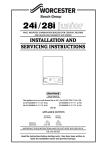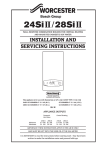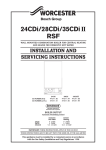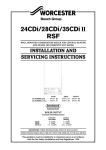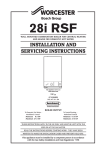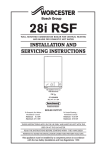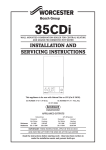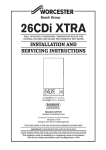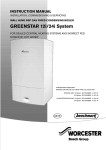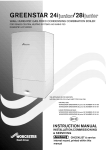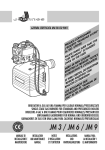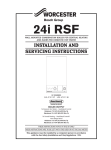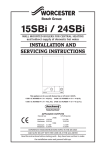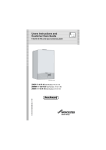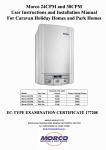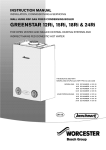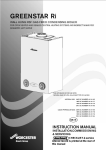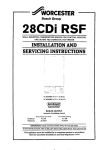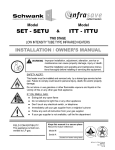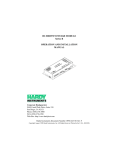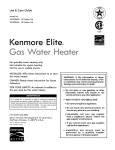Download Worcester 28i Junior Specifications
Transcript
24i / 28i junior WALL MOUNTED COMBINATION BOILERS FOR CENTRAL HEATING AND MAINS FED DOMESTIC HOT WATER INSTALLATION AND SERVICING INSTRUCTIONS This appliance is for use with Natural Gas or LPG (Cat II 2H3P TYPE C12 & C32) 24i GC NUMBER 47 311 69 (N.G.) GC NUMBER 47 311 71 (L.P.G.) 28i GC NUMBER 47 311 70 (N.G.) GC NUMBER 47 311 72 (L.P.G.) GB/IE APPLIANCE OUTPUTS Worcester, Bosch Group, Cotswold Way, Warndon, Worcester WR4 9SW. Telephone: (01905) 754624. Fax: (01905) 754619. Worcester, Bosch is a trading name of BBT Thermotechnology UK Ltd. Technical Helpline (08705) 266241. www.worcester-bosch.co.uk This booklet is accurate at the date of printing but will be superseded and should be disregarded if specifications and/or appearances are changed in the interests of continued improvement. All goods sold are subject to our official Conditions of Sale, a copy of which may be obtained on application. PUBLICATION 8 716 108 402b 02/07 Minimum Maximum Domestic Hot Water Central Heating 24i 7.5 kW 23.5 kW 28i 8.0 kW 27.5 kW IMPORTANT: THESE INSTRUCTIONS MUST BE LEFT WITH THE USER OR AT THE GAS METER Read the instructions before starting work - they have been written to make the installation easier and prevent hold-ups. Contents commissioning procedure to confirm gas soundness and correct boiler operation. 10. Check and adjust the setting pressures to the values in the table overleaf and adjust if necessary. Refer to Installation and Service Instructions Section: Replacement of Parts. “To Set the Burner Pressure”. 20. Conversion Instructions 1. Installation Regulations . . . . . . . . . . . . . . . . . . . . . . . . . . . Page 2 2. Introduction . . . . . . . . . . . . . . . . . . . . . . . . . . . . . . . . . . . . . Page 2 3. Technical Data . . . . . . . . . . . . . . . . . . . . . . . . . . . . . . . . . . . Page 5 4. Siting the Appliance . . . . . . . . . . . . . . . . . . . . . . . . . . . . . . Page 8 5. Flue Terminal Positions . . . . . . . . . . . . . . . . . . . . . . . . . . . . Page 8 6. Air Supply . . . . . . . . . . . . . . . . . . . . . . . . . . . . . . . . . . . . . . . Page 9 7. Sealed System . . . . . . . . . . . . . . . . . . . . . . . . . . . . . . . . . . . Page 9 8. Open Vent System . . . . . . . . . . . . . . . . . . . . . . . . . . . . . . . . Page 9 9. Domestic Hot Water . . . . . . . . . . . . . . . . . . . . . . . . . . . . . Page 10 10. Gas Supply . . . . . . . . . . . . . . . . . . . . . . . . . . . . . . . . . . . . Page 10 ......................................................... 11. Electrical . . . . . . . . . . . . . . . . . . . . . . . . . . . . . . . . . . . . . . Page 10 12. Installing the Appliance . . . . . . . . . . . . . . . . . . . . . . . . . . Page 13 13. Commissioning the Appliance . . . . . . . . . . . . . . . . . . . . Page 20 14. Handover . . . . . . . . . . . . . . . . . . . . . . . . . . . . . . . . . . . . . . Page 22 15. Inspection and Service. . . . . . . . . . . . . . . . . . . . . . . . . . . Page 22 16. Replacement of Parts . . . . . . . . . . . . . . . . . . . . . . . . . . . . Page 25 17. Short Parts List . . . . . . . . . . . . . . . . . . . . . . . . . . . . . . . . . Page 31 18. Operational Flow Diagrams. . . . . . . . . . . . . . . . . . . . . . . Page 33 19. Fault Finding . . . . . . . . . . . . . . . . . . . . . . . . . . . . . . . . . . . Page 35 20. Conversion Instructions . . . . . . . . . . . . . . . . . . . . . . . . . . Page 43 1.9 LPG Installation: The appliance shall not be installed in a room or internal space below ground level when it is intended for use with LPG. This does not preclude the installation into rooms, which are basements with respect to one side of the building but open to the ground on the opposite side. 1.9.1 CARAVAN AND HOLIDAY HOMES The installation must meet the following standards. BS5482:2 LPG and EN721 ventilation. 1. Installation Regulations The appliance is suitable for installation in GB and IE only and should be installed in accordance with the rules in force. 1.1 Gas Safety (Installation & Use) Regulations 1998: It is the law in GB that a competent person in accordance with the above regulations installs all gas appliances. Failure to install appliances correctly could lead to prosecution. It is in your interest, and that of safety, to ensure compliance with the law. 1.9.2 PARK HOMES AND RESIDENTIAL The installation must meet the following standards. BS5482:1 LPG and BS3632 ventilation. 1.2 The manufacturers notes must not be taken, in any way, as overriding statutory obligations. 1.10 These instructions cover, as far as possible, the foreseeable situations, which may arise. Contact Worcester, Bosch Group Technical Department, Telephone: 08705 266241, for advice on specific installations. In Eire call 01 494 0099. 1.3 The compliance with a British Standard or European Norm does not, in itself, confer immunity from legal obligations. 1.4.1 The installation of the appliance must be in accordance with the relevant requirements of the Gas Safety Regulations, current IEE Regulations, Building Regulations, Building Standards (Scotland) and local water by-laws. 2. Introduction 2.1 The Benchmark initiative is the new code of practice to encourage the correct installation, commissioning and servicing of domestic central heating boilers and system equipment. The 'Log-book' is a vital document that must be completed by the installer at the time of installation. It confirms that the boiler has been installed and commissioned according to the manufacturers instructions. A Declaration of Conformity (refer to IS813 Annex D 1) must be completed by the installer and a copy supplied to the appliance operator for boilers installed in Eire. Without the completion of the Log-book and/or Declaration, manufacturers may refuse to respond to a call-out from a householder, who will be advised that he or she must call back the installer, who has not fulfilled his obligations to record the information required by the initiative. Service: To ensure the continued efficient operation of the appliance it must be checked at regular intervals. The frequency of servicing will depend upon the particular installation conditions and usage, but once per year should generally be adequate. The extent of the service required by the appliance is determined by the operating condition of the appliance when tested by fully qualified engineers. Any service work must be carried out by competent registered (by CORGI in GB) engineers. 1.4.2 In Eire, the installation must be carried out by a competent person and installed in accordance with IS813, Domestic Gas Installations (Edition 2), the current Building Regulations and the electrical installation must follow the ETCI rules. 1.5 The installation should follow the recommendations of the following British Standards unless otherwise indicated. BS5440:1 - Flues and ventilation for gas appliances: Flues BS5440:2 - Flues and ventilation for gas appliances: Air supply. BS5449 - Central heating for domestic premises. BS5482 - Domestic propane gas burning installations. BS5546:1 - Installation of gas hot water supplies. BS6700 - Domestic water supply in buildings. BS6798 - Installation of gas fired hot water boilers. BS6891 - Low pressure gas pipework installations upto 28mm (R1). BS7593 - Water treatment. BS7671 - Requirements for electrical installations (16th Edition). British Standards and Regulations are not in force in Ireland, however useful information relating to the hydraulic aspects of heating systems may be found in IS 813: Annex M and in BS5546, BS5449, BS7074 and BS7593. 1.6 The appliance and components must conform, where applicable, to all relevant Directives. 2.2 General Information The appliance is set to give the maximum output of 27.5 kW [28i] or 23.5kW [24i] to the domestic hot water and to the heating system. The hot water flow rate is limited to a nominal 10 l/min [28i] or 8 l/min [24i] at a maximum temperature rise of 40°C. The sanitary water section of the appliance is suitable for a mains water pressure of up to 10bar. An internal filling loop assembly approved by the WRAS is an optional extra. The 28i is only manufactured for use with Natural Gas. Kits are available for the 24i and 28i appliances to convert from Natural Gas to LPG operation and vice versa. 1.7 The appliance does not contain any substances which are harmful to health. 1.8 In certain circumstances, the installer can be held responsible, not only for mistakes on his part but also for damage resulting from the use of faulty materials. We advise that, to avoid any risk, only quality approved branded fittings and the specified replacement parts are used. 2 ONLY COMPONENTS SUPPLIED BY WORCESTER HEAT SYSTEMS SHOULD BE USED ONLY COMPETENT PERSONNEL SHOULD ATTEMPT THE CONVERSION Max 2mm Allen key CONVERSION FROM NATURAL GAS TO LPG SHOULD NOT BE CARRIED OUT ON APPLIANCES INSTALLED IN A ROOM OR INTERNAL SPACE BELOW GROUND LEVEL Burner pressure test point 1. Ensure the gas service cock is turned OFF and the electrical supply is ISOLATED. 2. Refer to the Servicing Instrucions to remove the cabinet front panel and inner casing. 3. Follow the dismantling instructions to remove the burner. Refer to Installation and Service Instructions Section: Inspection and Servicing. 4. Remove the injector and replace with the relevent injector from the kit. Refer to Installation and Service Instructions Section: Inspection and Servicing. 5. Remove the nut end cap and bracket at the opposite end of the burner and insert the gauze from the kit for NG to LPG or remove it for LPG to NG. 6. Refit the end cap ensuring that the support bracket is in the correct orientation. 7. Remove the gas valve and replace with the gas valve supplied in the kit. Refer to Installation and Service Instructions Section: Replacement of Parts. 8. Re-assemble the burner and inner-casing. 9. Turn on the gas and electricity supplies and follow the Table 1. 24i Electrical connections modulator (Blue:Blue) Inlet pressure test point Clockwise to increase Anti-clockwise to decrease Slight movement only is required 11. Refit the plastic sealing cap to the gas valve modulating valve adjuster and seal with a dab of paint or similar. 12. Turn off the boiler and when cool peel off the arrow from the data plate on the combustion chamber front panel and re-stick against the gas type for which the boiler has been converted and adjusted. 13. Replace the boiler front panel. The conversion is now complete. Table 1. 28i NOMINAL BOILER RATINGS (10 Minutes After Lighting) BOILER ADJUSTED FOR G20 (Natural Gas) BURNER OUTPUT INPUT (Net) GAS RATE PRESSURE kW kW m bar. m3/h 8.0 9.5 1.2 1.00 27.5 30.0 14.7 3.17 BOILER ADJUSTED FOR G31 (Propane) 9.5 4.6 0.39 25.9 35.0 1.06 8.0 27.5 Natural Gas: Net Input = Gross Input x 0.901 QTY 1 1 1 1 1 2 1 1 1 1 1 Gas valve sealing cap Main gas valve connections NOMINAL BOILER RATINGS (10 Minutes After Lighting) BOILER ADJUSTED FOR G20 (Natural Gas) BURNER OUTPUT INPUT (Net) GAS RATE PRESSURE kW kW m bar. m3/h 3.5 9.5 1.4 1.00 23.5 25.9 13.6 2.74 7.5 23.5 Min 3mm Allen key BOILER ADJUSTED FOR G31 (Propane) 9.5 3.4 30.0 35.3 LPG (Propane): Net Input = Gross Input x 0.922 DESCRIPTION Conversion Instructions LPG Gas Valve Dungs BM771 sl 040 (for LPG to NG) NG Gas Valve Dungs BM771 sl 040 (for NG to LPG) Burner gauze Fibre washer O rings Injector 2.7mm 24i LPG Injector 2.78mm 28i LPG Injector 4.3mm 24i NG Injector 4.5mm 28i NG Copper washer 43 PART No 8 716 105 654 8 716 105 650 8 716 142 601 8 710 103 043 8 716 140 827 8 716 156 373 8 716 140 209 8 716 105 033 8 716 140 208 8 716 101 994 0.39 1.23 TEST G Is the boiler in a very cold environment (less than 5°C)? No 2.3 Electrical Supply 230V - 50Hz. Load 152 watts. External fuse 3A, Internal fuses F1 - 2A, F2 - 1.25A (20mm). Replace control board. Note: A damp board could cause this fault. 2.4 Gas Supply The appliances require a maximum of 3.17 m3/h of natural gas (G20) or 1.23 m3/h of propane (G31) [28i] or 2.74 m3/h of natural gas (G20) or 1.06 m3/h of propane (G31) [24i]. The installation and the connection of the gas supply to the appliance must be in accordance with BS6891 in GB and, IS813 in Eire. The meter or regulator should deliver a dynamic pressure of 20 mbar (G20) or 37mbar (G31) at the appliance, which is equivalent to about 18.5 mbar or 36 mbar at the gas valve inlet pressure test point. Yes TEST H Boiler is running in “Autofrost stat” mode. See Section 17. Hot water temperature always too hot during a demand (not regulating). The Central Heating Temperature control knob provides for the selection of domestic hot water only (turned fully anti-clockwise) or central heating and domestic hot water (turned clockwise). A facia mounted programmer is provided as an optional extra. A remote mounted programmer may be connected to the appliance. There is provision for the connection of a mains voltage room thermostat and/or a frost thermostat. The electronic controls prevent rapid cycling of the appliance in the central heating mode. 2.8 System These appliances are suitable for sealed systems only. All dirt must be flushed from the system before connecting the appliance. The system can be pre-piped and flushed before the appliance is fitted. If a system cleaner has been used then it must be completely removed before initially filling the system and adding, where necessary, an inhibitor. The connections in the system must withstand an operating pressure of upto 3 bar. Radiator valves must conform to BS2767: 10:1977. Table 3 gives the pump head available for the system and the required temperature differential. A drain cock must be fitted to the lowest point and an air vent to the highest point of the system. In Eire the requirements in respect of the system given in the current Irish Building Regulations must be followed and further guidance is available in Annex M of IS813. 2.5 Installation The appliance is suitable for indoor installation only and for use with a sealed system only. Do not place anything on top of the appliance. This is a room sealed appliance and a separate combustion air supply is not required in any room or compartment in which the appliance is fitted. If the appliance is fitted in a cupboard or a compartment is built around it after installation, then the structure must conform to the appropriate standards. However, because of the low casing losses, there is no need for cooling ventilation openings in the compartment provided that the specified clearances are maintained. The spaces specified for servicing must be maintained.(See Table 8). There is space for the service pipes to pass through the side channels at the back of the appliance. Hot water sensor could be off or poorly fixed to pipe. Repair or replace. 2.9 Showers, Bidets, Taps and Mixing Valves All taps and mixing valves must be suitable for the available mains pressure and temperatures up to 65oC. It may be necessary to fit a pressure reducing valve. Hot and cold mains fed water can be supplied to overrim bidets but is subject to local water company requirements. The flow of water from individual outlets varies on all mains fed systems that are not fitted with flow balancing valves. Thermostatically controlled or pressure equalising shower valves give extra comfort and protection. If a pressure equalising valve is fitted then the domestic hot water temperature should be set to maximum. 2.6 Flue Does the problem occur in CH mode only? TEST I Yes No Problem occurs in the HW mode only. Check flow sensor: with boiler cool, slowly open a HW tap. Does the boiler ignite with a flow of about 3 l/min? (Check using a measuring jug and stop watch i.e 500ml in 10 sec. No Turbine sticking or seized. Replace the turbine. Yes Standard Multi-Directional Horizontal Flue Kit can be adjusted from 425mm to 725mm without cutting. The minimum length is 265 mm with cutting. Extended flue lengths up to a maximum of 3m are available. Optional 45° and 90° flue bend kits are available NOTE: When using flue bends the maximum flue length is reduced. If access to the flue terminal will be a problem then a kit is available to enable the horizontal flue to be fitted from inside the house. Do not allow the flue terminal fitted to the outside wall to become obstructed or damaged. A terminal guard, Type K2, GC 393 553, is available from Tower Flue Components, Vale Rise, Tonbridge, TN9 1TB. A vertical flue system is available with a maximum height of 4.1m including the flue terminal assembly. Refer to the separate vertical flue system booklet . 2.10 Safety The appliance must not be operated with the inner casing cover removed or without being full of water and pressurised. The gas and electricity supplies must be turned off before working on the appliance. The appliance can only be electrically isolated externally. Temperature monitoring controls are fitted to prevent overheating. Automatic frost protection is provided together with automatic pump seizure protection. The gas valve solenoids are automatically checked for gas soundness. IMPORTANT: Where back-flow prevention devices, including water meters, are fitted the expansion of hot water into cold water main can be prevented. This can result in a pressure build-up that may cause damage to the boiler and household devices such as showers, washing machines etc. In these cases we recommend that a mini-expansion vessel be fitted adjacent to the boiler in the cold water inlet pipe. The domestic hot water circuit should be in copper pipe. Fig. 1. Facia controls It is not possible to easily isolate the fault. The most likely causes are control board (fail), heat exchanger (blocked) or gas valve (sticking). 6 3 5 4 1 2 2.11 Operation 2.11.1 Central Heating: A demand for heat will ignite the burner. It will operate at minimum pressure for 19 seconds before increasing to the maximum pressure over a period of 1 minute and then automatically match the system requirements. At the end of the demand the burner will go out, the pump will continue to run for up to 3 minutes and the fan for 35 seconds. There is an anti-cycle time of 3 minutes. 1. Central Heating temperature 4. Optional timer control On/Off knob 5. Fault indicator and 2. System pressure gauge reset button 3. Burner ON indicator 6. User guide location 2.7 Controls The electronic control system and gas valve modulate the heat input in response to the domestic hot water temperature and the central heating setting. 42 3 2.11.2 Domestic Hot Water: The appliance can provide domestic hot water whenever it is switched on electrically. A demand for hot water will light the burner. The pressure will immediately rise to maximum. At the end of the demand the fan will continue to run for 35 seconds if there is no heating demand. In winter it may be necessary to reduce the flow at the taps to maintain the delivery temperature. Yes Replace multiway connector to position ST16 (but not fan connector at ST1) and reset/restart the boiler. Is there mains 230V across the right (L) and left (N) tracks at board position ST1? NOTE: Take care not to short L to N. 2.11.3 Domestic Hot Water and Central Heating: The demand for hot water will override the central heating function when the appliance is in the heating and hot water mode of operation. No Replace control board. In the unlikely event of this not solving the problem replace code plug. Yes Replace fan connector ST1. Remove electrical connectors from air pressure switch and reset/restart boiler. Is there continuity between C and NO terminals (where wires were fitted) when the fan runs? (Test within 30 seconds). Fig. 2. Water flow diagram. 10 8 No Pressure switch has not closed. Are the silicon tubes in good condition and free of condensation. No Replace tubes. If condensation has occurred, also replace pressure switch and check condition of Venturi in the fan. Yes Inspect the flue. Is it free of any restrictions? No Rectify flue problem. Yes 9 Replace air pressure switch. Note: In the unlikely event of this not solving the problem inspect the pressure pick-up (Venturi) in the fan or fan may not be running freely. Yes 6 Does the burner ignite (burner light on) and run for a short priod before the fault occurs? 11 No Remove multiway connector from board position ST16. Is there continuity of the green cables to the air pressure switch? No Yes 7 Yes Replace control board. Pressure switch has opened during operation. Check flue for blockage. Also investigate sense tubes and pressure switch. 12 1. 2. 3. 4. 5. 6. 7. 2 5 CH flow Domestic hot water flow Mains cold water inlet CH return Pressure relief valve discharge Domestic water flow turbine Circulating pump 3 8. Expansion vessel 9. Primary heat exchanger 10. Expansion vessel charge point 11. Relief valve 12. Boiler drain point 13. Charging link (optional extra) 4 4 13 TEST F 1 The gas valve mode switch (concealed by the facia side panel) is not set correctly Turn to 'NORM' position 41 Repair cables or replace main harness. Is the multiway connector at board position ST16 pushed fully home on to the board? 3. Technical Data No Push fully home Table 1. No Re-fix sensor onto pipe Yes Remove multiway connector from board position ST16. Test resistance across pins 16 and 17 ( yellow wire). Is it between 1 kOhm and 30 kOhm? 7.5 23.5 No Is there continuity from individual pins 16 and 17 to DHW sensor? No TEST E No 110 INTERNAL FIX mm 130 EXTENDED FLUE 275/*425 MAXIMUM LENGTH mm 725 MAXIMUM LENGTH mm 3000 FLUE ASSEMBLY DIAMETER mm 100 MAXIMUM LENGTH mm 3000 mm 1100 TERMINAL ASSEMBLY * NOTE : Minimum uncut length Table 3 Air pressure switch is shorting. Check tubes for blockage or replace switch. MAXIMUM AVAILABLE PUMP HEAD HEAD Metres MIN. FLOW RATE L/min. FLOW/RETURN DIFFERENTIAL °C 8 4.5 10.4 11 23.5 2.2 18.3 18 27.5 2.0 18.3 21 BOILER OUTPUT kW Yes No Table 4 MECHANICAL SPECIFICATIONS CENTRAL HEATING FLOW - COMPRESSION Yes mm MINIMUM LENGTH mm VERTICAL DUCT Yes No Repair or replace harness. EXTERNAL FIX VERTICAL FLUE Check or replace CH sensor. Test resistance across contacts to black & red cables. Is it between 30 and 90 ohms? Table 2. STANDARD FLUE No BOILER ADJUSTED FOR G31 (Propane) 9.5 3.4 30.0 35.3 LPG (Propane): Net Input = Gross Input x 0.921 WALL HOLE DIAMETER Yes Turn off electrical supply. Remove fan connector from board position ST1. Test resistance across contacts to black & white cables. Is it between 75 and 175 ohms? 8.0 27.5 HORIZONTAL FLUE Yes Test resistance across contacts 14 and 15 (green wire). Is it open circuit? BOILER ADJUSTED FOR G31 (Propane) 9.5 4.6 0.39 25.9 35.0 1.06 FLUE DETAILS Yes Is there continuity from individual contacts 12 and 13 to CH sensor? 28i NOMINAL BOILER RATINGS (10 Minutes After Lighting) BOILER ADJUSTED FOR G20 (Natural Gas) BURNER OUTPUT INPUT (Net) GAS RATE PRESSURE kW kW m bar. m3/h 8.0 9.5 1.2 1.00 27.5 30.0 14.7 3.17 Natural Gas: Net Input = Gross Input x 0.901 Repair or replace harness. Check or replace DHW sensor. Test resistance across contacts 12 and 13 (red wire). Is it between 1 kOhm and 30 kOhm? Table 1. NOMINAL BOILER RATINGS (10 Minutes After Lighting) BOILER ADJUSTED FOR G20 (Natural Gas) BURNER OUTPUT INPUT (Net) GAS RATE PRESSURE kW kW m bar. m3/h 7.5 9.5 1.4 1.00 23.5 25.9 13.6 2.74 Yes Check the DHW sensor. Is it correctly fitted onto the pipe with heat conductive paste between the pipe and sensor? 24i Check/repair fan harness or repalce fan. Yes RETURN - COMPRESSION 22mm 22mm 15mm 15mm DOMESTIC WATER FLOW - COMPRESSION 15mm 15mm 3 Rp ⁄4 3 Rp ⁄4 RELIEF VALVE DISCHARGE 15mm 15mm CASING HEIGHT 600mm 600mm CASING WIDTH 400mm 440mm CASING DEPTH 325mm 325mm WEIGHT - LIFT 22kg 23.5kg WEIGHT - PACKAGED 37kg 40kg WEIGHT - DRY 40 28i 22mm COLD WATER INLET - COMPRESSION GAS INLET No 24i 22mm 34.7kg 5 37.5kg 0.39 1.23 Table 5 PERFORMANCE SPECIFICATIONS PRIMARY WATER CAPACITY litres IP RATING (WHOLE OF BOILER) 24i 3 28i 3 IP 20 IP 20 MAXIMUM MAINS INLET PRESSURE bar 10 10 MINIMUM MAINS INLET PRESSURE (WORKING) FOR MAXIMUM FLOW bar 0.9 0.9 MINIMUM MAINS INLET PRESSURE (WORKING) FOR OPERATION bar 0.1 0.1 DOMESTIC HOT WATER TEMPERATURE RANGE °C 55 55 MAXIMUM CENTRAL HEATING FLOW TEMPERATURE °C 82 (nom) 82 (nom) MAXIMUM CENTRAL HEATING SYSTEM SET PRESSURE bar 2.5 2.5 MINIMUM CENTRAL HEATING SYSTEM PRESSURE bar 0.5 0.5 NATURAL GAS (G20) 23.5 27.5 LPG - PROPANE (G31) 23.5 27.5 DOMESTIC HOT WATER SPECIFIC RATE - 30°C RISE l/min 11.2 13.1 MAXIMUM DOMESTIC HOT WATER FLOW RATE - 40°C RISE l/min 8.4 9.8 FLUE GAS MASS FLOW RATE 15.2 17.8 FLUE GAS TEMPERATURE °C 150 150 OUTPUT TO CENTRAL HEATING & DHW kw NOx CLASSIFICATION FOR BOTH 24i & 28i Class 2 SEDBUK NUMBER NG 78.0 78.9 SEDBUK NUMBER LPG 80.4 82.1 D D SEDBUK BAND* * The value is used in the UK Government Standard Assessment Procedure [SAP] for the energy rating of dwellings. The test data from which it has been calculated have been certified by the GASTEC notified body. DOMESTIC HOT WATER TEMPERATURE RISE 7 8 24i 48 42 28i 56 49 9 37 44 10 34 39 Table 7 Table 8 *ABOVE FLUE ELBOW BENEATH THE APPLIANCE IN FRONT OF APPLIANCE RIGHT/LEFT HAND SIDE (mm) SERVICE 30 200 600 10 No Re-fix sensor to pipe. Yes Remove combustion chamber cover. Is the sense electrode and lead in good condition and is gap correct? No Replace flame sensor or wiring. Yes Remove multiway connector from board position ST16. Is there continuity from pin 10 (white wire) to flame sensor? No Yes No Check flashing occurs at the end of a demand. Gas valve leak is detected. Check flashing occurs during a demand. Pump could be partially blocked. Clean pump & flush system. Yes Replace control board. NOTE: It is not possible to reliably check the cross-light performance of the burner or the efficiency of the gas/water heat exchanger. If there is still a problem, investigate flue problems or replace burner or injector or heat exchanger. GAS SUPPLY SYSTEM - BASED ON NG (G20) TOTAL LENGTH OF GAS SUPPLY PIPE (COPPER) metres 3 6 9 12 GAS DISCHARGE RATE - PRESSURE DROP 1 mbar. — m3/h PIPE DIAMETER mm 8.7 5.8 4.6 3.9 22 18.0 12.0 9.4 8.0 28 CLEARANCES INSTALLATION 30 200 600 10 Turn off boiler. Remove inner casing cover and check position of primary sensor (on heat exchanger in front of overheat thermostat). Is it correctly fixed to pipe? Check the flashing fault signal occur at the start of a demand. Table 6 DISCHARGE RATE l/min TEMPERATURE RISE °C TEMPERATURE RISE °C Yes UNVENTILATED COMPARTMENT 30 200 25** 25 Refer to Section 6. * If vertical flue then 200mm above top of boiler. ** Front clearance is to a removable panel (eg. door). Table 9 INITIAL PRESSURE bar 1.0 1.5 SYSTEM CAPACITY TOTAL SYSTEM VOLUME litres INITIAL CHARGE PRESSURE bar 0.5 1.0 1.5 57 75 N/A 31 42 52 6 39 Is the gas supply connected and at the correct pressure? No Fig. 5. Pipework connections Rectify gas supply problem. Yes Remove front panel. Reset and restart the boiler. Can a flame be seen through the spy glass? No Is the boiler fully water pressurised and is all air vented? No Rectify fault Yes Remove inner cover. Reset and restart the boiler. Does a spark occur across the electrodes? No Are the electrodes and gap and connections in good order? No Repair or replace spark electrode or HT leads Test continuity of each ignition cable. A Minimum system flow rate No Replace (both) ignition cables Dimensions A,B,E,F B Please ensure that the external system flow rate returning to the appliance is greater than 2 litres/minute. Yes Yes 18 130 C D E Fig. 3. Appliance casing dimensions and required clearances for installation/servicing F Yes Yes TEST D Turn off boiler. Remove the multiway connector from board position ST16. Test resistance across pins 1 and 2 (brown wires) also pins 8 and 9 (violet). Is resistance between 60Ω and 100Ω ? 30 Replace control board. No Yes Remove brown connector from gas valve. Is there continuity from brown and violet connectors to multiway connector? 158 No 24i = 400 Repair or replace harness. No Remove blue connector from gas valve. Is there continuity from blue wires to multiway connector? 10 10 200 No Repair or replace harness. All dimensions in mm Unventilated Compartment — for clearances refer to Table 8 Fig. 4. Appliance casing dimensions and required clearances (side view). Yes Yes Replace gas valve Is there continuity between pins 6 and 7? (orange wires to HL stat) No Replace overheat stat or wiring to it. 102 203 600 Yes 600 325 Replace control board. If problem not solved replace gas valve. 200 Reset and restart the boiler in CH mode. Does the pump run? No Replace or repair pump. All dimensions in mm Unventilated Compartment — Refer to Table 8 Yes 38 CH Flow Relief Valve Discharge DHW Outlet Gas Cold Water Inlet CH Return = = = = = = 24i 70 88 135 200 265 330 28i 90 108 155 220 285 350 All dimensions in mm 28i = 440 Yes Replace gas valve. Test resistance across pins 4 and 5 (blue wires). Is resistance between 10Ω and 25Ω ? A B C D E F 7 Notwithstanding the instructions given in BS 5440:2, these appliances can be fitted in a compartment with no vents as long as the clearances specified in Table 8 are maintained. LPG Installation. Refer to Section 1.9. 4. Siting The Appliance The appliance may be installed in any room but refer to the requirements of the current IEE Regulations and, in Scotland, the relevant electrical provisions of the Building Regulations with respect to the installation of appliances in rooms containing baths or showers. In Eire refer to the ETCI rules for electrical installations. Where a room sealed appliance is installed in a room containing a bath or shower, any switch or appliance control using mains electricity must NOT be able to be touched by a person using the bath or shower. The IP rating of the appliance may only allow it to be located in specific 'zones'. Refer to, in GB, Electrical Regulations 16th Edition (BS7671). The appliance is NOT suitable for external installation No special wall protection is required. The wall must be able to support the weight of the appliance. Refer to Table 4. The specified clearances must be available for installation and servicing. Refer to Table 8. The appliance can be installed in a cupboard/compartment to be used for airing clothes providing that the requirements of BS6798 and BS5440 Part 2 are followed. Refer to Section 2.5. The clearance between the front of the appliance and the cupboard or compartment door should be not less than 25mm. The airing space must be separated from the boiler space by a perforated non-combustible partition. Expanded metal or rigid wire mesh is acceptable provided that the major dimension is less than 13mm. Disconnect the 3 way in-line connector to the turbine. Is there 5VDC between the two outer pins (main harness side)? Take care not to damage the pins. 5. Flue terminal positions Re-connect the 3-way connector and open a tap to run the turbine. Is there between 1.5V and 4.5V across the green and black wires/terminals? Is there continuity in the main harness? No Yes Yes TEST C The flue system must be installed following the requirements of BS5440: 1. In Eire the flue terminal must be sited as described in in Table 5 of the current edition of IS813. Standard horizontal flue kit length is 265 – 725mm with extension kits for flues up to 3m. The terminal must not cause an obstruction or the combustion products a nuisance. Under some conditions the terminal might emit steam and positions where this might be a nuisance should be avoided. Refer to Fig 6. If the terminal is less than 2m above a surface to which people have access then a guard must be fitted. The guard must be evenly spaced about the terminal and fixed with plated screws. A Type K2 guard is available from Tower Flue Components, Vale Rise, Tonbridge, TN9 1TB. A vertical flue kit is available giving a maximum height of 4.1m including the flue terminal assembly. Refer to the separate vertical flue system booklet. No Replace control board. Yes No Replace turbine. Fig. 6. Siting of the flue terminal. P Q Q D,E. I J N Q B F M C N L A I G TERMINAL POSITION N K H H M MIN. DISTANCE Aa– Directly below an opening, air brick, opening windows etc. 300 mm B– Above an opening, air brick, opening windows etc. 300mm C– Horizontally to an opening, air brick, opening windows etc. 300mm D– Below gutters, soil pipes or drain pipes. 75mm E– Below eaves. 200 mm F– Below balconies or car port roof (lowest point). 200 mm G– From a vertical drain pipe or soil pipe. 150 mm H– From an internal or external corner. 300 mm I– Above ground, roof or balcony level. 300 mm J– From a surface facing the terminal. 600 mm K– From a terminal facing the terminal 1200 mm L– From an opening in a car port (e.g. door window) into dwelling. 1200 mm M– Vertically from a terminal on the same wall. 1500 mm N– Horizontally from a terminal on the same wall. 300 mm O– From the wall on which the terminal is mounted N/A P– From a vertical structure on the roof N/A See Vertical Flue Q– Above intersection with roof b Instructions NOTE N/A = Not applicable a In addition, the terminal should be not nearer than 150mm (fanned draught) to an opening in the building fabric formed for the purpose of accommodating a built-in element such as a window frame. Not recommended b 8 37 Replace main harness. The pump is set at maximum and should not be adjusted. All connections in the system must withstand a working pressure of up to 3 bar. The radiator valves must conform to BS 2767:10 and other valves to BS1010. 6. Air Supply NOTE: It is normal for there to be no facia lights if the boiler is in normal overtemperature condition. Continue this test if this fault occurs when the appliance is cold. 6.1 A separate vent for combustion air is not required. Refer to BS5440:2. Fig 8a - System make up 2 7. Sealed System TEST A Is there a 230V AC live supply across Terminal ST2 pins L and N? No Check electrical supply to boiler. Yes Switch off electrical power. Has fuse F1 blown? No Has fuse F2 blown? No Yes Yes Yes Replace fuse. This will be caused by fuse fatigue or by the board. Replace fuse and investigate cause. Suggestions: Cable damage, connections to (or faults within) pump, fan, external 230V controls, transformer or board. Replace transformer. NOTE: Lights will be off and pump will run if boiler is in 3min anticycle condition. With CH control knob fully clockwise, if there is still no CH function, continue: TEST B Is there a 230V AC live supply across Terminal ST2 pins Lr and N? No Remove control board from facia and separate transformer from board. Measure resistance across the two pairs of adjacent pins on the transformer. Is any coil above 100 ohms? There is no heat demand. Check room thermostat or external programmer (or link). No Replace control board. 4 1 The system must comply with requirements of BS6798 and BS5449 and, in EIRE, the current edition of IS813. It must not be operated without being full of water and correctly pressurised. Otherwise a lockout fault will occur when the boiler is powered up. The pressure relief valve will operate at 3 bar. The discharge pipe, of 15mm diameter, must be directed such that the discharge of water or steam is visible, will not discharge onto the occupants of the premises or cause any damage to the premises, in particular any electrical components or wiring. The expansion vessel, to BS4814, has a capacity of 6 litres charged to 0.5 bar, which is suitable for a static head of 5 metres. A schraeder type valve allows the pressure to be increased if the static head is greater than 5 metres. If the expansion vessel fails then it must be replaced with the designated spare part. Refer to BS 7074:1, BS5449 and Table 9 for a guide to the available system capacity. The maximum system design pressure is 1.5 bar. If the pressure is above 2.65 bar when the appliance is at maximum temperature then an additional expansion vessel must be fitted as near to the appliance as possible in the return pipe. The pressure gauge shows the system pressure. Fill and pressurise the system through a WRAS approved filling loop. The system and the appliance must be fully vented. Repeated venting loses water from the system, which must be replaced. The make-up connection must be close to the appliance in the heating return pipe through an approved non-return valve. Plastic pipes must not be directly connected to the boiler. A copper to plastic transition piece should be positioned a minimum of 600mm from the boiler. A plastic pipe with a polymeric barrier must be used. The connection to the mains water supply must have the approval of the local Water Company. An integral non-adjustable by-pass is fitted . 3 5 300mm Above the highest point of the system 1.Central Heating Return 2.Auto Air vent 3.Non-return Valve 4.Make-up Vessel 5.Stop Cock Fig 8b - Filling loop Mains water supply Heating return Non return Non return valve valve Hose union Stop cock Temporary hose Test cock 8. Open Vent System This appliance is NOT suitable for connection to an open vent system. Fig. 7. Sealed primary water system. Yes Is there a facia mounted programmer at connection ST5 at right-hand end of board? No Replace control board. Refer to 'Water Flow Diagram' Fig.2. Yes Remove programmer connector from edge of board. Does the boiler now ignite? Mains cold water APPLIANCE Radiator valve No Hot water out Lockshield valve Heating return Yes Heating flow Correctly set or replace programmer. NOTE: A drain cock should be installed at the lowest point of the heating circuit and below the level of the appliance. 36 Cold water inlet British Standard stop valve. Fixed spindle type Water main 9 9. Domestic Hot Water 11. Electrical It may be necessary to contact the local Water Company before connecting the appliance. Where back-flow prevention devices, including water meters, are fitted the expansion of hot water into cold water main can be prevented. This can result in a pressure build-up that may cause damage to the boiler and household devices such as showers, washing machines etc. In these cases we recommend that a mini-expansion vessel be fitted adjacent to the boiler in the cold water pipe. In Eire advice on backflow protection is given IS813 Annex M4.3 and M4.4. The connection in the domestic water system should be in copper pipe. The domestic hot water circuit of the appliance is suitable for a mains pressure of up to 10bar. A pressure reducing valve must be fitted if necessary. A mains water supply isolating valve is fitted. The maximum hot water flow rate is set at the factory to 8 l/min [24i] and 10 l/min [28i] giving a nominal temperature rise of 40oC with the temperature control at maximum. This rate is equivalent to a Specific Rate of 11.2 l/min [24i] and 13.1 l/min [28i] at a rise of 30oC. Refer to Table 6. The temperature rise, upto the maximum, is maintained by the automatic modulation of the heat input. In winter (when the mains water temperature is lower) it may be necessary to reduce the water flow at the tap or shower to maintain the maximum delivery temperature. It is recommended that long pipe runs to taps or showers are insulated to prevent the rapid cooling of the water. Hot and cold taps and mixing valves must be suitable for the available mains pressure. No anti-syphonage arrangements are necessary for fixed head showers. The hose of a loose-head shower must be fixed so that the shower head cannot get closer than 25mm to the top edge of the bath to prevent its immersion in the water. Alternatively the shower can be fitted with an anti-syphonage device at the flexible hose connection. Thermostatically controlled or pressure balancing shower valves will give extra comfort and guard against extreme temperature. Hot and cold mains water direct to a bidet is, subject to the approval of the local water company, permissible provided that the bidet is of the overrim flushing type. The outlets must be shrouded and unable to be fitted with a hand-held spray. No antisyphon arrangements are needed. LIME SCALE: In areas of temporary hardness [>200ppm of calcium carbonate] it is suggested that a proprietary scale reducer is fitted in the mains cold water connection to the appliance. Installation of a scale inhibitor assembly must be in accordance with the requirements of the local Water Company. The water hardness can be determined by reference to the local Water Company. An isolating valve should be fitted to allow servicing. Safety Check: If there is an electrical fault after installation check for fuse failure, short circuits, incorrect polarity of connections, earth continuity or resistance to earth. Mains supply: 230V ~ 50 Hz 150watts. External fuse 3A to BS1362. Internal fuses F1-T2A, F2-TI.25A (20mm). Spare internal fuses are supplied with the appliance. The mains cable must be 0.75mm2 (24x0.20 mm) to BS6500 Table 16 and must be connected to the terminal ST2 marked L (red or brown lead), N (black or blue lead) and the Earth stud (green or green/yellow lead) and secured with the cable clamp. The Earth lead must still be slack when the other leads are taut. Refer to Fig 29. The appliance must be earthed. The wiring between the appliance and the electrical supply shall comply with current IEE wiring regulations (and any local reguations which apply) for fixed wiring to a stationary appliance. NB. It must be possible to completely isolate the appliance with at leaste 3mm contact separation in both poles. A room thermostat or an externally mounted programmer must be suitable for mains voltage operation. The leads must be securely fixed in the cable clamps (see Fig 31). A facia mounted digital programmer or mechanical timer or receiver for wireless programmable room thermostat is available as an optional extra. Instructions are supplied with the product. On very rare occasions it may be necessary to fit an external frost thermostat to protect remote parts of the system. In this case refer to the WHS Technical Department for more information Tel: 08705 266241 (UK) . 01 494 0099 (Eire) 19. Fault Finding Note: This fault-finding information is for guidance only. Worcester Heat Systems cannot be held responsible for costs incurred by persons not deemed to be competent. By flashing at various rates, the oval shaped facia light will indicate specific fault conditions. If this is used with other observations during a fault, then every normal fault can be identified. To use the fault finding system, use the table below to select the failure condition during your fault. The most common causes are listed, then refer to the test in the following section. This fault finding system assumes that the appliance has been operating normally until the time of failure (ie not a first installation fault). PRELIMINARY CHECKS Preliminary electrical system checks are the first electrical checks to be carried out during a fault-finding procedure. On completion of the Service/Fault-Finding task which has required the breaking and remaking of electrical connections, check (a) EARTH CONTINUITY, (b) SHORT CIRCUIT CHECK, (c) POLARITY and (d) RESISTANCE TO EARTH. FAULT LIST OBSERVED FAULT COMMON CAUSES SEE TEST No lights and no functions (with demand) No mains Voltage supply. Fuse F1 or F2 blown. Transformer or connector failed. Board fault. A No CH function (DHW OK) No link at ST2 Ls to Lr, or failed external control input to Lr. Failed programmer. Board fault. B No DHW function (CH OK) Flow sensor failure. DHW sensor (LED 4 flash/second). Board fault. C Flash once per second No gas or low gas gas pressure. pressure. Weak spark or spark spark not not across across electrodes. elecrodes. Gas Gas valve valve leaking leaking or or failed. failed. Low boiler Low water water pressure pressure or or dry boiler dry.during normal operation, standby or directly after power up. Pump fail. Pump fail. Primary sensor position. Primary sensor position. Flame sensor sensor fail fail or or connector. connector. Flame Overheat stat tripped or disconnected disconnectedor orfaulty. faulty. Overheat stat tripped or Blocked burner. burner. Blocked exchanger. Blocked heat exchanger. Faulty Harness. harness. Board fault fault. D Ignition lockout Overheat lockout Internal error (reset lockout by gently pressing reset button for 5 seconds) Flash 4 times per second CH or DHW Sensor fault or out of position. Air pressure switch fault or condense in tubes. Fan fail or stiff. Blocked flue. Faulty harness. Board fault. E 10. Gas Supply The appliance requires a maximum of 2.74 m3/h [24i], 3.17m3/h [28i] of natural gas (G20) or 1.06 m3/h [24i], 1.23m3/h [28i] of propane (G31). Refer to Table 7. A natural gas appliance must be connected to a governed meter. The installation and connection of the gas supply to the appliance must be in accordance with BS6891. The meter (NG) or regulator (LPG) and the pipework to the appliance must be checked, preferably by the gas supplier, to ensure that a dynamic pressure of 20mbar for natural gas or 37mbar for propane is available at the appliance (contact gas supplier if in doubt) equivalent to about 18.5mbar [NG] or 36mbar [LPG] respectively at the gas valve inlet pressure connection and that the gas flow is adequate for all the installed gas appliances operating together. 10 Flash 4 times per second Gas Valve mode switch on min or max. F Burner on with no demand Autofroststat. Board fault. Water temperature too hot Sensor off pipe. G H Water temperature too cool Low gas pressure. Pot P1 not turned up. Stiff/sticking gas valve. Stiff/sticking flow sensor. Board fault. 35 I OVERRUN FUNCTION Fig. 9. Wiring diagram. Overheat cut-off device There is a delay of 6 seconds, pump pulses for 2 seconds, 60 second wait, 2 second pump pulse, 60 second wait, pump pulses for 2 seconds. END DHW DEMAND Fan low speed 35 seconds END CH DEMAND Air Pressure Switch Fan Black 6.3mm tag Common White 4.8mm tag Low Speed Red 2.8mm tag High Speed Fan low speed if primary temp above 85°C until below 80°C. Pump runs for 3 minutes Flame sense electrode Spark electrode DHW sensor Gas valve Regulator Valve AUTOFROSTAT FUNCTION CH sensor No demand and primary temperature below 8°C Pump Safety Valve Flow turbine Monitor central heating sensor Below 5°C 5°C to 9°C Above 9°C Return to normal off state Control Board green/yellow ST2 ST16 ST15 black Link blue Mains in brown blue black green white ST1 2 brown white red Commence normal central heating mode until temperature reaches 20°C Spark Generator brown Run pump 4 min ON 30 min OFF Earth tabs Internal "Autofrostat" demand Safety Valve 2 red 2 green 2 yellow 34 11 2 blue 2 orange 2 violet white 18. Operational Flow Diagrams 24V programmer (if applicable) Overheat cut-off Flame sense Air pressure switch DHW sensor CH sensor Flow sensor Main valves CENTRAL HEATING FUNCTION MAIN SWITCH ON Room thermostat and/or mains programmer (or link) On AND facia programmer (if fitted) On AND CH control knob On Inputs Indicators Red Outputs CH Control knob Electronics/ microprocessor (Safety Low Voltage) Settings Red Flame detect Error indicator indicator/reset Regulator valve Fig. 10. Functional flow diagram. CENTRAL HEATING DEMAND Gas valve mode switch Convert AC to low voltage electronics Three minute wait ST1 right pin ST2 (LR) ST2 (NS) Transformer Modulate gas to maintain flow temperature set by control knob (50-82°C) N red white ST1 centre pin Fan Flow sensor signal (Tap open) MAIN SWITCH ON Pump (Ls) (for other features) ST2 centre pole ST15 right pin ST2 (LS) ST2 Pin N Overrun function (see overleaf) Over temperature shutdown if flow temperature 5°C above set value Gas valve Off. Burner light off. (Pump still On) Electronics DOMESTIC HOT WATER DEMAND (Priority over CH demand) YES Is CH interrupted? Pump continue 4 seconds if primary temp above DHW setting. Burner to MAX. Modulate gas to maintain delivered water temperature (55°C) NO Ignition sequence and burner to MAX DHW temp drops to <55°C Gas valve off. Primary 78°C Gas valve off. Pump on Over temperature shut-down if water temperature above 80°C LIVE IN 12 DEMAND END DOMESTIC HOT WATER FUNCTION low high Optional link Room thermostat On/Off switch Fuse F1 (2A Slow) ST2 Pin L 19 second minimum burner pressure then ramp up pressure over next one minute Electronics Electronics N Fuse F2 (1.25A Slow) Spark electrodes Spark Reset button Pump on. Fan ON/ ignition sequence. Burner Light On. Primary temperature 94°C 33 DEMAND END Overrun function (see overleaf) 12. Installing The Appliance 6 9 1-2 27 NOTE: READ THIS SECTION FULLY BEFORE COMMENCING THE INSTALLATION. 11.1 General The appliance is only suitable for fitting to a sealed system. The flue must be installed as specified in BS5440:1 and the current Building Regulations, and, in Eire in accordance with the current edition of IS813. 10 8 11.2 Unpacking Open the carton and check the contents against the packing list. 10 3-4 Fig. 12. Wall mounting assembly 11.3 Boiler Preparation 7 28 14 -15 16 12 -13 17 Lift out the wall mounting assembly. NOTE: The wall mounting assembly can be removed from the carton without having to remove the boiler. 1 11.4 Site Preparation Check that the correct position for the appliance has been chosen. Refer to Section 4 and Table 8. Check that the wall is flat and will support the weight of the appliance. Refer to Table 4. 11.5 Fixing Holes and Flue Opening Hold the template against the wall. Check that the template is level and mark the position of the upper keyhole fixing holes and the flue opening. Refer to Fig 11. Mark the centrelines of the pipe connections to aid the preplumbing of the system pipework if required. Check the position of the fixing points and flue opening before drilling the fixing holes 60mm deep for the No. 12 size plugs and cutting the flue duct hole at 110mm diameter [150mm diameter for internally fitted flues]. 2 3 4 6 11.6 Wall Mounting and Manifold Assembly Fit the plugs and insert the screws. Check that all the service valves are closed on the manifold assembly. Offer the assembly to the wall utilising the keyhole slots and fix to the wall. Refer to Fig 12 and 15. Check that the assembly is properly aligned before tightening the screws. 18 20 19 14 5 11.7 Gas and Water Pipes Fit the appropriate fitting to connect the gas cock to the gas supply pipe. Refer Fig 13. Pre-plumbing is not recommended if no movement in the pipes is available. If it is necessary for any of the pipes to run up the back of the appliance then they must be arranged to pass each side of the expansion vessel in the channels provided. Refer to Fig 12. Pipework must not run horizontally within the limits of the casing. It is important that the pipes are not fixed near the appliance using clips that put a strain on the connections. 9 11 12 ! IMPORTANT Before the appliance is fitted to the wall thoroughly flush the system and mains water supply. 25-26 7 13 11 6 Fig. 11. Side flue opening 8 1. Wall mounting frame assembly 2. Relief valve 3. Relief valve drain connection 4. System connection 5. Manifold assembly 6. Spring clip 7. Expansion vessel 8. Expansion vessel charging point 9. Filling Loop (optional extra) 10. Channels for system pipes 11. Flexible connector from pump ( SECURE IN POSITION WITH SPRING CLIP ) ! 12. Lower fixing screws (2) 13. O-Ring 14. Washers 102 203 24 21-23 5 All dimensions in mm 32 13 17. Short Parts List Fig. 15 . Appliance location Fig. 13 . Manifold assembly 1 Fibre Washer 2 4 65 CH Flow 65 65 65 3 DHW Flow Gas DHW Cold * Inlet CH Return Lower fixing screws (2) * Filling loop not shown All dimensions in mm 1. Casing location bracket 2. Appliance location bracket 3. Wall mounting frame 4. Pipe channel Fig. 14 . Facia cover 1 Unscrew the facia fixing screws. Refer to Fig 18. Unhook the panel and lower it into the bottom support lugs. Do not strain the support strap. Refer to Fig. 18 and 41. Fix the boiler at the right and left to the mounting frame using the two lower fixing screws provided. Refer to Fig. 13 and 16. 5 Remove the protective cap from the flexible hose. Check that the O-ring is in good condition. Connect the hose to the system connection pointSECURE IN POSITION WITH SPRING CLIP. IMPORTANT Refer to Figs 12 & 17. Fit a discharge pipe to the relief valve leading it away from any electrics or where it might be a hazard. The pipe must not be less than 15mm in diameter and must run continuously downward outside the appliance. Refer to Fig. 17. ! Key No. G.C. No. 1 2 3 4 5 6 7 8 9 10 11 12 13 14 15 16 17 18 19 20 21 22 23 24 25 26 27 H05-333 H05-352 H05-337 H05-338 E80-454 E94-710 E01-612 H05-408 173-015 375-696 E88-181 H05-261 H05-264 H05-247 H05-248 E88-176 375-699 H05-366 H05-206 H05-452 H05-229 H05-231 H05-239 E88-183 E88-184 E88-184 H05-403 Part Burner 24 NG Burner 28 NG Gas Valve NG Gas Valve LPG Air Pressure Switch E lectrode Spark E lectrode FlameSense Fan Overheat Stat Thermistor Sensor Flow Sensor Heat Exchanger 24 kW Heat Exchanger 28 kW Insulation Set 24 kW Insulation Set 28 kW Pressure Gauge Pressure Relief Valve Pump Expansion Vessel Control Board Silicone Sponge 24/28kW sides Silicone Sponge 24kW top/bottom Silicone Sponge 28kW top/bottom Transformer Flow Regulator 24kW White Flow Regulator 28kW Blue Auto Air Vent Qty WHS Part No. 1 1 1 1 1 1 1 1 1 1 1 1 1 1 1 1 1 1 1 1 1 1 1 1 1 1 1 8 716 105 484 0 8 716 105 485 0 8 716 105 654 0 8 716 105 650 0 8 747 004 461 0 8 716 105 186 0 8 716 120 345 0 8 717 105 652 0 8 716 142 303 0 8 716 142 302 0 8 716 146 164 0 8 716 105 482 0 8 716 105 483 0 8 716 105 936 0 8 716 105 937 0 8 716 142 398 0 8 716 142 404 0 8 716 105 656 0 8 716 105 545 0 8 748 300 484 0 8 716 105 766 0 8 716 105 767 0 8 716 105 768 0 8 747 210 294 0 8 716 141 255 0 8 716 141 253 0 8 716 106 142 0 1 1 1 1 1 1 1 2 1 1 1 1 1 7 716 192 281 7 716 192 282 8 716 105 967 7 716 192 290 7 716 191 068 7 716 191 079 7 716 191 013 7 716 191 014 7 716 191 016 7 716 192 246 7 716 192 027 7 716 192 028 7 716 192 030 Fig. 16 . Appliance fixing Accessories and Kits 2 3 1 4 1. Cabinet 2. Control 3. Facia cover 4. Facia cover clips (4) 5. Cabinet fixing screws (2) 11.7 Install the Boiler Check that the gas and water valves are closed. Refer to Fig 13. Fit the fibre washers, in the hardware pack, to the service valves on the manifold. Remove the two fixing screws. Lift the appliance to the wall, engage in the top support and lower onto the manifold assembly. Tighten the gas and water connections. 2 A001 A002 A004 A005 A006 A007 A008 A009 A010 A011 A012 A013 A014 Charging Link Assembly Installer Pre-Filling Kit Gas Conversion Kit NG to LPG 24kW Gas Conversion Kit NG to LPG 28kW Simplefit Telescopic Flue Kit Vertical Flue Kit 90° Flue Elbow - F106E90 45° Flue Elbow (Pair) - F 106E45 Vertical Flue Adaptor Kit Security Kit Mechanical Programmer Digital Programmer Digistat 1. Appliance fixing bracket 2. Fixing screw 14 31 Fig. 17 . Relief valve discharge connection Fig. 19. Flue spigot and restrictor Fig. 61. Primary heat exchanger 1 6 1 4 2 5 4 5 ! IMPORTANT 2 3 7 1 2 1. 2. 3. 4. 3 Flue spigot fixing screws Flue spigot Restrictor ring Flue spigot fixing holes 4 8 6 Fig. 20. Standard flue assembly 3 20 Auto Air Vent Remove the complete pump assembly as described in Section 16.18. Take care not to strain the electrical connections. Pull out the clip securing the auto air vent cartridge. Refer to Fig 52. Do not omit the O-ring when fitting the new cartridge. Refit the pump assembly as described in Section 16.18 preceding. 1. Heat exchanger 4. Overheat thermostat 2. O-ring (4) 5. Central heating flow and return 3. Fixing clip (4) 6. Domestic hot water inlet and outlet 1. Relief valve 2. Relief valve discharge connection 3. Relief valve securing clip 4. System connection point 5. Expansion vessel connection Fig. 62. Air pressure switch 5 6. Expansion vessel securing clip 7. Flexible connector from pump with O-ring 8. System connection securing clip Flue turret assembly Fixing screw Telescopic adjustment Appliance Fig. 18. Inner case and facia fixing 21 Primary Heat Exchanger Check that the appliance has been fully drained. Remove the temperature sensors as described in 15.15, 16 and 17 preceding. Remove the combustion chamber cover, fan and flue hood and burner as described in Section 15.3, Inspection and Servicing. Remove the combustion chamber insulation side panels. Prise off the fixing clips securing the copper pipes. Remove the heat exchanger. Do not omit the O-rings when fitting the replacement heat exchanger. Refer to Fig. 61. Check that the rear seal for the flue hood is in good condition and secure before replacing the flue hood. Terminal assembly L casing 3 4 11.8 Air and Flue Duct Preparation 11.8.1 The method of installation of the flue system may be varied to suit the actual site conditions. The instructions for connecting and fixing the ducts must, however, be strictly followed. 1 3 Remove all packing material from the flue components. 11.8.2 RESTRICTOR RINGS Flue length Horizontal up to 1m Horizontal above 1m Vertical terminal and up to 1m flue Vertical flue greater than 1000mm 1 4 22 Air pressure switch Pull-off the silicone sensing tubes. Unscrew the fixing bracket and remove the pressure switch. See Fig 62. Unscrew and remove the fixing clip and fit to the new air pressure switch ensuring that the orientation of the switch to the air connections is the same. Refit the switch assembly. Remove the electrical connections from the old switch and fit to the new switch in the same position. Refit the silicone sensing tubes - the red tube fixes to the rear of the switch. 2 9 OPAQUE RED 6 2 7 5 8 2. Tube connectors 23 Sight Glass Remove and replace the inner casing cover complete. Inspection and Servicing. Refer to Section 15. 3. Electrical connections 4. Air pressure switch fixing bracket 5. Fixing screw 30 28i 80mm None 80mm None 11.8.3 Fit the flue restrictor ring by unscrewing the flue spigot from the boiler. Refer to Fig. 19. The standard telescopic flue assembly is suitable (without cutting) for flues from 425mm up to 725mm measured from the centre-line of the boiler flue outlet to the outer face of the wall. Refer to Fig. 20. The minimum length of the standard flue, after cutting is 275mm. If L is greater than 725mm then extension duct kit/s will be required - each kit extends the flue by 750mm up to a maximum of 3000 mm. 6 10 1. Air pressure switch 24i 76mm None 76mm None 1. Inner casing cover 2. Control panel fixing screws (2) 3. Inner casing cover fixing screws (2) 4. Control panel 5. Controls connector cover 6. Controls connector cover fixing screws (2) 7. Programmer (optional) 8. Facia control panel fixing screw 9. Top support lug (2) 10. Bottom support lug (2) EXTENSION 1 2 3 15 MAXIMUM FLUE LENGTH mm 1475 2225 2975 Fig. 21. Extension duct Terminal assembly L Flue turret assembly Fixing screw Fixing screw casing Fig. 22. Flue duct length - side Terminal assembly L Flue turret assembly Fig. 23. Flue duct length - rear It is not necessary to cut the ducts Flue turret assembly L Terminal assembly If L is between 1175 - 1475mm 1925 - 2225mm 2675 - 2975mm (1 extension) (2 extension) (3 extension) It will be necessary to cut the ducts If L is between 725 - 1175mm 1475 - 1925mm 2225 - 2675mm (1 extension) (2 extension) (3 extension) It is necessary to shorten the assembly by cutting the first extension duct assembly eg. L = 1000mm — remove 175mm from the air and flue ducts (1175 – 1000 = 175mm). 11.9 Measure and Cut the Ducts. General: Cut the ducts as necessary, ensuring that the cuts are square and free from burrs. Always check the dimensions before cutting. Measure the distance L. Refer to Fig. 20, 21, 22 and 23. NOTE: Extension duct measurements do not include the socketed end. Unless specifically instructed the socketed end must not be removed. The standard flue can be telescopically adjusted to any length between 425mm and 725mm measured from the centre of the turret without the need to cut the ducts. Fix the flue assembly together using the self-tapping screws provided. Refer to Fig. 20. 11.10 Fitting the Flue Assembly with Access to the Terminal. Prepare the flue duct assembly as described in Section 11.8. Apply the plastic tape to the air duct to be in contact with the external brickwork. From inside push the assembly through the wall. Align the flue turret and push fully onto the spigot on the appliance. Tighten the clamping ring. Refer to Fig. 24. Fix the flue ducts together before fixing the surrounding air duct. The cut ducts fit into the terminal assembly. It will only be necessary to cut the standard assembly if L is less than 425mm. Cut the flue turret assembly and the terminal assembly by the same amount eg. if L=350 – remove 75mm (425 — 350) from each assembly. Make good the internal wall face and the external brickwork or rendering. 16 19 Expansion Vessel It will be necessary to remove the appliance from the wall to replace the expansion vessel. Alternatively the specified replacement can be fitted into the heating system return as close to the appliance as possible. Re-fill and pressurise the system as described in Section 13 Commissioning. 16 Primary Overheat Thermostat Remove the clip-on facia cover,cabinet and the inner casing cover. Carefully pull-off the connections. Unscrew the two screws and remove the thermostat and fixing bracket. Refer to Fig. 59. Apply a small quantity of heat transfer paste to the face of the replacement thermostat. Carefully position the thermostat so that the connections are away from the flue hood. Ducts of equal length Appliance 15 Primary [ch] Sensor Remove the clip-on facia cover and the cabinet. Lower the facia onto the support lugs. Carefully pull-off the connections. Release the clip and remove the sensor. Refer to Fig. 58. Do not omit the heat transfer paste when fitting the replacement sensor. Fig. 58. Primary (CH) sensor. 3 2 17 DHW Sensor Remove the clip-on facia cover and cabinet. Lower the facia onto the lower support lugs. Carefully pull off the connections. Unscrew the clip and remove the sensor. Apply a small quantity of heat transfer paste to the face of the replacement sensor. Refer to Fig. 60. 1 18 Pump Check that the system valves have been shut and the appliance has been fully drained. NOTE: A little water will remain in some components. Remove the clip on facia cover and cabinet. Place the facia control panel onto the lower support lugs. Remove the burner as described in Section 16.4 preceding. Disconnect the flexible hose at the relief valve assembly. Pull out the clip to disconnect the pressure gauge capillary head. Refer to Fig. 52. Raise and remove the clip securing the by-pass pipe to the central heating flow pipe. Refer to Fig. 52. Pull out the flat clip securing the brass fitting at the top of the pump. Unscrew the fitting from inside the combustion chamber. Refer to Fig. 41. Undo the union connection beneath the pump and carefully withdraw the pump. Take care when releasing the by-pass pipe. Support the pump and disconnect electrically. Transfer the by-pass pipe, expansion vessel flexible connector and the drain point and pressure gauge connector to the new pump. Transfer the inlet and outlet connections. Use new O-rings and seals where necessary. Reconnect the electrical leads. Fit the new pump assembly in the reverse order using new Orings and seals where necessary. ! IMPORTANT 1. Primary Sensor 2. Fixing clip 3. Flow pipe Fig. 59. Overheat thermostat 2 3 1 4 1. Heat exchanger manifold 2. Overheat thermostat 3. Fixing clamp 4. Water pressure switch connection point Fig. 60. DHW sensor Do not forget to re-connect the expansion vessel flexible pipe to the relief valve assembly. Refer to Fig. 17. 1. DHW sensor 2. DHW sensor fixing clip and screw Alternatively: Unscrew, using a 4mm Allen to release the four fixing screws, and remove the pump head. Refer to Fig. 45. Access is improved if the pressure gauge head and bracket are temporarilly removed. Transfer the electrical connections to the new pump head and set the speed at maximum. Refit the pump head taking care not to scratch the pump mating faces. Open the system valves and re-fill, re-pressurise and fully vent the appliance and the system ensuring that there are no air-locks. 2 1 29 9 Inlet Water Filter and Flow Restrictor Remove the flow turbine as described in 16.8 preceding. Taking care, remove flow restrictor assembly from the flow turbine. Carefully clean wire mesh by back flushing with water or replace assembly if necessary. Refer to Fig. 55. 12 Clock/Programmer Remove the clip-on facia. Remove the clock/programmer assembly by releasing the clip at the top of the clock/programmer and ease away from the control panel being careful not to pull on the connector lead. Unplug the connector at the control board. Refer to Fig. 57. Comprehensive instructions are sent with the new control. Fig. 55.Inlet water filter 1. Filter 2. Restrictor Prepare the flue assembly as described in Section 11.8. Fig. 24 . Flue Turret Fixing Fit the rubber sealing gasket centrally onto the terminal assembly and tighten the clamp. Refer to Fig. 25. Apply the plastic tape to the air duct to be in contact with the external brickwork. 1 From inside push the assembly through the wall so that the gasket flange is against the outer face. Refer to Fig. 25. It may be necessary to adjust the legs of the flue centering ring. Align the flue turret and push fully onto the socket on the appliance. Tighten the clamping ring. Refer to Fig. 24. Seal the gap around the duct at the inner wall face with the flexible seal provided and make good. 2 2 Fig. 57. Programmer connection 3 1 11.12 Flue Bends. 90° and 45° bends are available. A maximum of two bends may be used in addition to the first bend on the flue turret. A 90° bend is equivalent to 750mm of straight duct. A 45° bend is equivalent to 375mm of straight duct. 1. Flue turret assembly 2. Clamp 3. Appliance 7 6 10 Control Board Check that the appliance is electrically isolated. Remove the clip-on facia cover, cabinet and the connections cover. Carefully disconnect all the electrical connections. Refer to Fig. 39. Remove the facia panel unscrew the four screws and remove the cover from the rear of the facia. Lift out the control board. Refer to Fig. 56. Pull out and transfer the transformer to the board. Re-commission the appliance to check and set the burner pressures. Refer to Section 13, Commissioning. The maximum flue assembly is 2250mm with 1x90° bend and 1500mm with 2x90° bends. Measure the lengths X,Y and Z. Refer to Fig. 26. The maximum value of X using the turret assembly only is 506mm. Reduce the ducts to the appropriate length eg. X = 406mm, cut 100mm from the air duct and 120mm (to cover the entry into the 45° or 90° elbow) from the flue duct. Refer to Fig. 27. Fig. 25 . Terminal assembly for internal fitting of the flue. 5 Fixing clamp Air duct Flue Terminal NOTE: The flue system ducts between the elbows, dimension Y, requires the socketed ends (of the first extension if two or more are used) to be removed and the air and flue tubes to be cut to the same length. Cut the ducts to a length Y – 162mm. Refer to Fig.26. The final section, dimension Z, of the flue system must include a section of plain duct assembly eg. an extension assembly with the sockets removed. Reduce the final section, including the terminal assembly, by the appropriate amount eg: Air duct Z - 81mm and the flue duct Z – 51mm. Refer to Fig.26. 4 3 Rubber sealing gasket Flue duct 11 Transformer Unscrew the four screws and remove the cover from the rear of the facia as described in 16.10 preceding. Pull out the transformer. Refer to Fig. 56. 2 OPTIONAL Fig. 56. Control board If Z is less than 425mm it will be necessary to cut the air and flue ducts of the extension to a plain length of 100mm and reduce the length of the terminal assembly eg. Z=350mm - remove 75mm from the terminal assembly. Rubber sealing gasket Flue terminal 3 1 1. 2. 3. 4. 5. 6. 7. 4 2 5 Facia Control panel (boiler outer casing in place) Programmer cover Programmer location Programmer connections Programmer connector plug Programmer Clamping ring 11.11 Fitting of the Flue Assembly without access to the Terminal. The rubber gasket kit is available from Worcester, Bosch Group. NOTE: A larger diameter (150mm) opening in the wall is required. Refer to Table 2. Fig. 26. Flue bends 13 Fan Remove the inner casing cover. Remove the fan as described in Section 15.4, Inspection and Servicing. Ensure that all the connections are correctly made to the new fan. 1 1. Control panel 2. Rear cover 3. Rear cover fixing screws (4) 14 Air Flow Detector Remove the fan as described in Section 15.4.13 Inspection and Servicing. Unscrew and withdraw, through the fan outlet, the airflow detector. Refer to Fig. 42. 4. Transformer 5. Control board 28 Z Y-162 Plain tube Y X 17 11.14 Completion of the Installation Check that all the gas and water connections on the manifold have been tightened. Undo the two screws and remove the connections cover panel. Refer to Fig. 29. Connect the mains supply lead to the appliance and secure the cable clamp. Refer to Fig. 29. Check that there is sufficient loose lead to allow the release of the facia panel assembly. Connect the earth lead. The earth lead of the mains supply must be longer than the live and neutral leads. Fit the facia mounted clock or programmer. Full instructions are sent with the control. Refer to Fig. 30. Connect any external controls ensuring that the leads pass through the appropriate cable clamp. Refer to Section 11 and Fig. 31. Test for gas soundness as described in BS6891. If the appliance is not to be commissioned immediately, replace the connection cover panel and the cabinet. Check that the gas and electricity services have been turned off. If Z is between 425 - 725mm it is not necessary to cut the terminal assembly or use a second extension duct as the length can be set telescopically. If Z is greater than 725mm then two extension duct assemblies will be required, the first assembly being cut to length as plain tubes. If more than two extension ducts are needed in any section to achieve the required length then the final section of the assembly must not be less than 275mm without cutting the terminal assembly. NOTE: The flue duct of the final extension must be 30mm longer than the air duct. Each section must be connected to the previous section of the flue bend by fixing the flue ducts together and then similarly fixing the air ducts which engage the elbows. Fit the assembly as described in Section 11.9, 11.10 as appropriate. Make good the internal and external brickwork or rendering. 11.13 Vertical Adapter for Horizontal Flues An adapter is available for an initial short section of vertical flue. Refer to Fig. 28. Measure and cut the flue as described in Section 11.12. The first, vertical, section (equivalent to dimension X) is measured from the top of the boiler casing. Cut the vertical section of the extension duct to 167mm less than the measured distance. Do not remove the socketed ends. The minimum measured distance is 167mm. Seal the air duct to the spigot using silicone sealant. Fig. 27 - Elbow to Flue Turret Assembly. 4 5 7 Fig. 50. Combustion Chamber Insulation. 3 2 6 1 2 Fig. 29. Facia connections 2 1. Pump 2. Pressure gauge connection 3. System connection hose 4. Air vent fixing clip 5. Air vent cartridge 6. By-pass pipe 7. 0-Ring 3 2 120mm 1 4 3 7 Relief Valve Remove the clip-on facia cover, cabinet, unscrew the single screw and lower the facia onto the lower support lugs. Check that the appliance has been fully drained. Disconnect the relief valve discharge pipe . Pull down the fixing clip and pull out the relief valve. Refer to Fig. 17. NOTE: The clip does not need to be fully removed. 1 1. Combustion chamber assembly 2. Rear insulation panel 3. Side insulation panel 4. Front insulation panel (fixed to combustion chamber front cover) 100mm *5mm Flue Turret Fig. 52. Pressure Gauge connection. 5 Combustion Chamber Insulation. Remove inner casing door and combustion chamber cover. Slide the damaged insulation panel from the appliance Rear Remove heat exchanger. Refer to Fig 61. Remove the side insulation panels. Slide the rear insulation forward and up to remove. Replacement is the reverse of removal. Refer to Fig 50. Bend *When connecting to an elbow the flue duct must be 5mm longer than the air duct. 4 5 14 ST2 Fig. 28 Vertical Adapter. 13 6 Series connection point Flue Duct Air Duct 7 11 9 8 1. Controls connector cover 2. Controls connector cover fixing screws (2) 3. Facia control panel 4. Earth connection (tags) Adapter 5. Earth connection (screws) 6. Cable clamp 7. Fuse F1 2A (slow) 8. Cable clamps (pump and fan) Flue Spigot 18 12 10 8 9. ST15 Pump 10. ST1 Fan 11. Fuse F2 1.25A (slow) 12. Commissioning switch (gas valve mode switch) 13. Internal controls connectors 14. Mains and external controls connectors Fig. 54. Water flow turbine. 6 Pressure Gauge Remove the clip-on facia cover, cabinet, unscrew the single screw and lower the facia panel onto the lower support lugs. Refer to Fig. 39 and 40. Check that the appliance has been fully drained. Slide the captive clip upwards and remove the pressure-sensing head. Refer to Fig. 52. Unclip the gauge head from its mounting bracket and remove. Refer to Fig. 51. Check the condition of the O-ring at the pressure capillary head before fitting the replacement gauge. 1 3 2 Fig. 51. Pressure Gauge head 1 1. Flow turbine 2. Clips (2) 3. O-ring 4. Filter/Flow restrictor 4 2 4 24i White 8 l/min 28i Blue 10 l/min 3 8 Flow Turbine/ Filter/ Restrictor Drain the DHW circuit as described at the start of Section 16. Remove the clip-on facia cover, cabinet, unscrew the single screw and lower the facia panel onto the lower support lugs. Separate the turbine in-line electrical connector. Remove the two fixing clips and withdraw the turbine assembly. 1. Pump 2. Pressure gauge capillary 3. Pressure gauge head 4. Mounting bracket 27 Fig. 47. Spark electrode assembly. 3 Flame Sense Electrode Remove the inner casing cover and the combustion chamber cover. Carefully pull off the lead from the electrode assembly. Remove the burner as described in the text following Unscrew the screw and remove the assembly. Refer to Fig. 48. Fig 31 - Mains Voltage External Controls Connections Fig. 30. Optional programmer connection 7 6 230 V Room Thermostat Connections Fig. 48. Flame sense electrode (rear view) Ns Ls LR spare 5 2 2 1. Flame sense electrode 2. Fixing screw 3. Burner blade assembly 230 V Programmer Connections 4 Burner Remove the inner casing cover and the combustion chamber cover. Carefully pull-off the connections to the spark electrodes and disconnect the flame sense electrode. Unscrew the single screw fixing the support bracket and withdraw the burner assembly. Refer to Fig 49. Flame sensor detail ST2 1 5-6mm 1. 2. 3. 4. 5. 6. 7. 3 4 Facia (gently pull forward to un-clip and remove) Control panel (boiler outer casing in place) Programmer cover (un-clip to remove) Programmer location in detail Programmer connections Programmer connector plug Programmer Switched Live Fig. 49. Burner Ns Ls LR spare Live 3 Remove Link 3 Neutral 2 Spark Electrode Remove the inner casing cover and the combustion chamber cover. Carefully pull off the lead from the electrode. Unscrew the screw and remove the assembly. Refer to Fig. 48. Ensure that the electrode is at the correct height above the burner blade. Neutral 4 3.5-4.5mm Switched Live ST2 Live 1 Remove Link Motor 1 230 V room thermostat and Programmer Connections Ns Ls LR Live Motor 5 3.5-4.5mm 1. Burner 2. Spark electrode assembly 3. Flame sensor 4. Burner injector 5. Support bracket fixing screw 2 Spark electrode detail 26 19 ive dL he itc Sw Ne ut ral e Liv Remove Link Neutral ST2 Check that the pressure relief valve operates by turning the knob anti-clockwise until it releases. Refer to Fig. 17. Water should be expelled from the discharge pipe. 13. Commissioning The Appliance In Eire additional guidance on commissioning is contained in paragraph 15 of IS 813:2001 13.1 Water Treatment: For optimum performance after installation, this boiler and its associated central heating system should be flushed in accordance with the guidelines given in BS7593 – Treatment of water in domestic hot water heating systems. Full instructions are supplied with proprietary cleansers sold for this purpose. If an inhibitor is to be used after flushing, it should be used in accordance with the manufacturers instructions. Remove all system cleanser before adding any inhibitor. Suitable flushing agents and inhibitors are available from Betz Dearborn on 0151 4209563 or Fernox Tel: 01799 550811. Fig. 34. Pump venting. Pump 13.2 This text describes the filling and venting of the appliance and system when the optional internal filling loop is fitted. Any external filling loop must be WRAS approved. Refer to Fig. 8 b. It is very important that the appliance and system are fully vented. Pull off the clip on bottom panel. Refer to Fig. 32. Remove the cabinet by pulling off the clip-on facia cover. Unscrew the two fixing screws, release the sides and lift from the top location. Check that the electrical supply and the gas supply to the appliance are turned off and that all the water connections throughout the system are tight. Open the system valves at the appliance. Refer to Fig 13. Open all the radiator valves. IMPORTANT: Turn off the gas supply and electrically isolate the appliance before replacing any components. NOTE: Turning the control knob fully anti-clockwise does not isolate the appliance electrically. After the replacement of any components always check for gas soundness where relevant and carry out functional checks as described in Section 13-Commissioning. Complete gasket and O-ring packs are available for gas and water connections on the appliance. Fig. 45 . Boiler drain point. 3 1 13.4 Set the Expansion Vessel Pressure The charge pressure of the expansion vessel as dispatched is 0.5bar, which is equivalent to a static head of 5m. The charge pressure must not be less than the static head at the point of connection. A Schraeder type valve is fitted to the top of the expansion vessel to allow the charge pressure to be increased if necessary. Refer to Fig. 15. The expansion vessel must be charged to 0.35bar less than the initial system design pressure. Fig. 32. Bottom Panel 2 Pump cap Electrical connections cover 3 Note: 1bar = 10.2m of water. 13.5 Set the System Pressure Fill the system until the pressure gauge is at 2.5bar and check for leaks. Turn the filling key anti-clockwise to shut the filling loop. Replace the key in the bottom panel. Release water from the system drain point until the required system pressure is obtained, upto a maximum of 1.5bar. Set the pointer on the pressure gauge to record the set system pressure. If the pressure indicated on the gauge is greater than 2.65bar when operating at the maximum central heating temperature then an extra expansion vessel must be fitted to the system as close as possible to the appliance central heating return connection. 1 1. Bottom panel 2. Filling key 3. Fixing clips Fig. 33. Filling Loop (optional) 4 4 1. Pump head 2. Boiler drain point 3. Flexible hose to expansion vessel connection 4. O-ring 2 Fig. 46 . Lower casing - gas and water controls. 9 13.6 Clock/Programmer The controls fitted to the appliance should be set up at this stage. Refer to the instructions sent with the control. 5 Fig. 35. Gas valve. Maximum 2mm Allen key 7 4 1 4 4. CH Return 5. Mains water inlet 5 13.3 Remove the key from the bottom panel and insert into the filling loop. Refer to Fig. 32 and 33. Open the mains cold water inlet valve . Turn the key clockwise to unlock the filling loop. The system will fill. Vent each radiator in turn. The automatic air vent will vent the appliance. It is very important that the appliance and system are fully vented and that all air pockets are removed. Remove the cap from the pump and turn the shaft about half a turn. Replace the cap. Refer to Fig. 34. 4 2 3 6 20 1 2 Minimum 3mm Allen key 1 2 1. Filling loop 2. Filling key 3. Lock/unlock Fill position DHW Circuit: Turn off the mains cold water supply at the appliance. Refer to Fig. 13. Open a hot tap below the level of the Component Access Refer to Section 15, Inspection and Servicing for access to components. Draining the Appliance Primary System: Turn off the heating flow and return valves at the appliance. Refer to Fig. 13. Open the drain tap. Fit a tube to the drain tap. Refer to Fig. 45. Close the drain tap when the flow from the appliance has stopped. appliance to drain the domestic hot water from the appliance. Important: A small quantity of water will remain in some components even after the appliance has been drained. Protect any electrical components when removing items from the water circuits. NOTE: After re-opening the mains cold water inlet valve, draw off a little water from a tap to ensure that there is water in the heat exchanger. Component Replacement Refer to Fig. 41 and 46 for an indication of the location of the various components. Replace any components removed from the appliance in the reverse order using new gaskets/O-rings/sealant/heat transfer paste where necessary. Always check that any electrical connections are correctly made and that all screws are tight. Remove casing and cover panels and lower the facia onto lower lugs, as necessary, to gain access to the components. Refer to Section 15, Inspection and Servicing. 1 Gas Valve Remove the burner assembly as described in Section 15.4. Carefully pull-off the electrical connections to the valve. Remove the injector and copper washer. Remove the two screws securing the manifold at the rear of the combustion chamber. Unscrew the union connection beneath the valve and ease the valve and injector manifold from the boiler. Use new gaskets when replacing the valve. Do not forget to replace the burner injector and copper washer. Set the Gas Valve: Connect a pressure gauge to the burner and inlet pressure test points on the valve. Refer to Fig. 35. Switch on the gas and electricity supplies. Check for gas tightness at the gas valve inlet. Refer to Section 13-Commissioning, for the method of checking the pressures. Check for gas soundness at the gas valve outlet. Adjust the maximum and start pressure [minimum], as necessary, to obtain the required pressures. Switch off the appliance and disconnect the pressure gauge and tighten the screw. Check for gas soundness at the test point. To set the burner pressure. Refer to Fig. 35. The minimum and maximum burner pressures must be set after a new gas control has been fitted. Only slight adjustment is required to change pressure. Follow the procedure described in Section 13 - Commissioning. The maximum burner pressure must be set first, as any adjustment of the maximum pressure influences the minimum pressure setting. Start the appliance in the domestic hot water mode as described in Section 13.8. - Appliance Operation. Turn the gas valve mode switch to maximum. Refer to Fig. 36. Adjust the maximum pressure adjustment screw on the gas valve to give a burner pressure of 13.6 mbar (24i), 14.7mbar (28i) for natural gas. For propane, the maximum pressure adjustment screw should be adjusted to give a pressure of 35.3mbar (28i). Turn the gas valve mode switch to minimum. Adjust the start pressure adjustment screw on the gas valve to give a pressure of 1.4mbar (24i), 1.2mbar (28i) for natural gas or 3.4mbar (28i), 4.6mbar (24i) for propane. Turn the gas valve mode switch back to normal. After completing the adjustments, check the minimum and maximum pressures and re-adjust as necessary. 16. Replacement Of Parts Clockwise to increase Anti-clockwise to decrease Slight movement only is required 1. Burner pressure test point 2. Main gas valve connections 3. Inlet pressure test point 4. Electrical connections modulator (Blue:Blue) 5. Gas valve sealing cap 6. Fibre washer 7. Injector 10 6 7 3 5 8 1. Gas valve 2. Pump 3. Pressure gauge 4. Relief valve 5. Manifold assembly 6. DHW sensor 7. DHW flow turbine 8. Filling loop assembly (optional extra) 9. CH sensor 10. Pump clip 25 Inner Case Cover Unscrew the two screws and lift off. Refer to Fig. 39. Combustion Chamber Cover Unscrew the two screws, lift and pull forward to remove. Refer to Fig. 41. Fan Carefully pull off the electrical connections and the tubes from the airflow-sensing device. Unscrew the three screws and remove the fan assembly. Refer to Fig. 42. Flue Hood Remove the fan. Slide out the hood. Ensure the rear seal is in good condition and secure before replacing the flue hood. Refer to Fig. 43. Burner Remove the combustion chamber. Carefully pull-off the connections to the spark electrodes and disconnect the flame sense electrode lead. Unscrew the support bracket and withdraw the burner assembly. Refer to Fig. 44. 15.5 Component Cleaning Only use a non-metallic brush to clean components. Do not use a metal probe to clean the injector. Clean the fan taking care not to block air flow sensor. Clean the burner to ensure that the blades are clear. Clean the electrodes, replace if there is any sign of deterioration. Clean the heat exchanger. Cover the burner injector. Remove any deposits from the heat exchanger from the top and bottom. Carefully straighten any distorted fins on the heat exchanger. Check the combustion chamber insulation and replace if there is any sign of damage or deterioration. Refer to Section 16.5. Clean the controls in-situ. Check that all screws are tight and the connections properly remade with the appropriate gaskets/O-rings/seals. Re-commission, as necessary, for correct operation to the users requirements. Refer to Section 13 Commissioning. Fig. 43. Flue hood Fig. 42. Fan assembly 1 13.7 Checking the Burner Pressure Unscrew the facia fixing screw. Unhook the panel and lower it into the bottom support lugs. Do not strain the support strap. Refer to Fig. 18. 13.8 Operation of the appliance Domestic Hot Water Turn the temperature control knob fully anti-clockwise to . Open a hot tap near the appliance. The burner will light and go to the maximum burner pressure appropriate to the appliance and the gas. Refer to Table 1. Gradually close the tap and check that the burner pressure falls. Fully open the tap and check that the pressure rises. Close the tap and check that the burner goes out. The fan may continue running until the appliance has cooled to a pre-set temperature. Fig.36. Mode adjustment Normal Central Heating Check that all the radiator valves are open. Check that the system is fully vented and set to the required pressure as indicated on the gauge. Check that the clock/programmer is set to operate continuously. Set the room thermostat and the heating temperature control to maximum. The burner will light and the appliance will modulate its output from minimum to maximum over a period of about two minutes. Check that all the radiators are heating up evenly. Shut down all but one of the radiators and observe the burner pressure fall. Open all the radiators and check that the burner pressure rises. Balance the system to give the required temperature differential. Refer to Table 3. Max Min 2 1 2 3 4 3 1. Flue hood 2. Rear sealing strip (on back panel) 3. Combustion chamber cover locating channel 1. Fan assembly 2. Flow sensor 3. Flue hood 4. Fan fixing screws (3) Fig. 44. Burner assembly 1. Burner assembly 2. Spark electrode assembly 3. Flame sense electrode 4. Injector 5. Support bracket fixing screw 24 Minimum system flow rate Please ensure that the external system flow rate returning to the appliance is greater than 2 litres/minute. Set the room thermostat to minimum and check that the burner goes out. Reset the room thermostat to maximum and the burner will relight and follow the normal operating procedure. Check flame failure device Turn off the gas service cock. The burner will go out but sparking from the electrode will continue for 10 seconds then the appliance will ‘lock-out’. After 60 seconds carefully open the gas service cock, press and hold-in before releasing the reset button and observe the burner re-light and follow the normal sequence of operation. Refer to Fig 13. Turn off the gas service cock and the electricity supply to the appliance. Check that the gas and electricity supplies are turned off. Connect pressure gauges to the gas valve to measure the inlet pressure and the burner pressure. Refer to Fig. 35. The appliance is fully set up in the factory and no adjustment should be necessary. Unscrew and remove the control connector cover to display the mode switch. Refer to Fig. 18. Check that all the radiator valves are open. Check that the system is fully vented and pressurised and set to the required pressure as indicated on the gauge. Set the temperature control knob to maximum and the clock/programmer to operate continuously. Fully open a hot tap. Set the mode switch to MAX. Refer to Fig. 36. Turn on the gas and electricity supplies. A continuous spark will occur until the burner is alight and sensed by the control circuit. The burner will remain at its maximum domestic hot water pressure for 1 minute. Refer to Table 1. It should not be necessary for the gas valve to be adjusted. Note: The burner pressure is factory set and if, after checking that the dynamic (working) supply pressure is sufficient i.e. 18.5mb approx. [NG] or 36mbar approx. [LPG] at the gas valve inlet pressure test point, the correct pressure cannot be obtained then Worcester, Bosch Group Service Department should be contacted. If the appliance does not light then check that it is not in the ‘lock-out’ state by gently pressing the reset button for 5 seconds. Refer to Fig. 37. Set the mode switch to Normal. Turn off the hot tap. The burner pressure will drop to the minimum setting and will ramp up to the maximum central heating pressure appropriate to the appliance and the gas. Refer to Table 1. Set the mode switch to MIN. The burner pressure will drop to the minimum burner pressure appropriate to the appliance and the gas for both the central heating and domestic hot water modes. Refer to Table 1. Set the mode switch back to Normal. Turn the electricity supply off and then back on to reset the controls. Replace the controls connector cover. Drain the system while the appliance is hot. Refill, vent and re-pressurise the system as described in the text preceding, adding, if necessary, a suitable proprietary inhibitor. Further information is available from Betz Dearborn Tel: 0151 4209563 or Fernox Tel: 01799 550811. Domestic Hot Water and Central Heating Set all controls to maximum. Turn on the electricity supply to the appliance and open the gas service cock at the appliance. The burner will light and heat will pass into the system. Turn on a hot tap and check that hot water is soon discharged from the tap. Close the tap and the burner will go off. The appliance will then return to the central heating mode and automatically balance with the system requirements. 13.9 Completion of Commissioning Turn off the appliance and disconnect the pressure gauge and tighten the test point screw. Restart the appliance and check for gas soundness around the test point screw. Refit the control panel, cabinet and the bottom panel. If the appliance is to be passed over to the user immediately then set the boiler and system controls to the users requirements. If the appliance is to be left inoperative in frosty conditions then set the programmer, if fitted, to off. Do not turn the electricity or gas supplies off. The appliance will operate under the control of the integral frost protection facility. If there is any possibility of the appliance being left totally unused in freezing conditions then switch off the gas and electricity and drain the appliance and the system. The appliance must be fully commissioned when it is returned to service. The venting of the system is very important. 21 NOTE: For flues greater than 725mm without a restrictor the CO2 may be up to 0.5% lower. These figures cover all flue conditions. 14. Hand Over 15.4 Component Access Isolate the electrical supply at the mains and turn off the gas supply at the gas service cock on the appliance before starting any service procedures. Always test for gas soundness after the service has been completed. To service the appliance it may be necessary to remove some or all of the following parts to gain access to components which may need to be checked or replaced. Cabinet Pull off the clip-on facia cover. Unscrew the two screws and release the cabinet sides. Lift up and away from the top locating pegs. Refer to Fig. 14 and 15. Facia Panel Unscrew the single screw, lift off and reposition onto the lower support lugs. Refer to Fig. 18 and 40. Fig. 40. Facia in service position Refit the cap after the test. Fig. 37. Facia controls 6 3 5 Fig. 38. Combustion Test Point 4 1 2 1 1. 2. 3. 4. Central Heating temperature control and On/Off knob System pressure gauge 5. Fault indicator and Burner ON indicator reset button Optional timer 6. User guide location Fig. 41. Inner case components 2 Hand over the User Booklet and the completed Benchmark Logbook and/or, in Eire, the Declaration . Explain how to operate the appliance safely and efficiently. Tell the user what to do if the appliance is not to be used in very cold conditions. Tell the user what to do if the system pressure falls. Explain that regular servicing will maintain the safe and efficient operation and extend the life of the appliance. Worcester, Bosch Group or their agent can offer a comprehensive maintenance contract. Tell the user that any work on the appliance must only be carried-out by a competent, CORGI (in the UK) registered, person. 9 1. Flue connections 2. Combustion products test point — + 8 Fig. 39. Inner case and facia fixing 1 2 7 3 15. Inspection And Service 1 15.1 To ensure continued efficient operation of the appliance it must be checked at regular intervals. The frequency of servicing will depend upon the particular installation conditions and usage, but once per year should generally be adequate. The extent of the service required by the appliance is determined by the operating condition of the appliance when tested by fully qualified engineers. Any service work must be carried out by competent registered engineers (CORGI in GB). 15.2 Inspection Check that the terminal and the terminal guard, if fitted, are clear and undamaged. If the appliance is in a compartment or cupboard check that the specified service space around the appliance is clear. Refer to Table 8. Check all the joints and connections in the system and remake any that show signs of leakage. Refill and re-pressurise as described in Section 13-Commissioning. Operate the appliance and take note of any irregularities. Refer to Section 19-Fault Finding for rectification procedures. 6 10 4 3 11 4 6 2 5 15.3 Combustion performance It is not normally necessary to check the combustion performance of the appliance. A sampling point is, however, provided. Refer to Fig. 38. The combustion performance figures given are for guidance. Remove the cap from the sample point on the top of the appliance. Connect the approved sampling meter. With the appliance at maximum rate and stable in the DHW mode expect readings of: 9 2 7 5 8 6 1. Inner casing cover 2. Cabinet fixing screws (2) 3. Inner casing cover fixing screws (2) 4. Facia control panel 5. Controls connector cover 6. Controls connector cover fixing screws (2) 7. Programmer (optional) 8. Facia control panel fixing screw 9. Top support lug 10. Bottom support lug NG CO2 6.5—7.5% CO 0.002—0.010% LPG CO2 7.5—8.5% CO 0.002—0.010% 22 10 1. Flue hood 7. Fan assembly 2. Overheat thermostat 8. Air pressure switch 3. Burner 9. Flue gas sampling point 4. Combustion chamber cover 10. Combustion chamber cover fixing screws 5. Spark electrode assembly 6. Heat exchanger 11. Pump connection 23






















